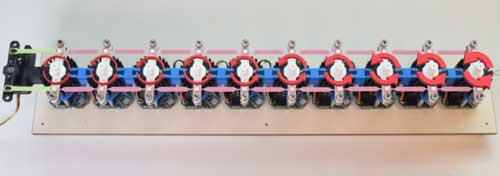| Oct 11, 2019 | |
Vibration in one direction only(Nanowerk News) Electronic components such as transistors transmit electric currents in one direction only. What if we could create materials that could achieve similar effects for mechanical vibrations? For many applications, having materials that transmit vibrations in one direction, but not in the other, would be extremely useful. |
|
| In nature, such materials do not exist, but a group of physicists from the University of Amsterdam has now designed a metamaterial that can do just that. | |
 |
|
| The newly designed material. It transmits vibrations from left to right, but not from right to left. | |
| Materials that show this ‘unidirectional transmission of motion’ could, for example, be used to build structures that would be much more resistant to earthquakes. Normal materials transmit information and energy – both wanted and unwanted – in every direction through mechanical vibrations. This happens at all scales: the surface of the earth during a quake is one example, but the same happens with the string of a guitar when it is plucked, or with our own tissues during an ultrasound. | |
Robotic meta-atoms |
|
| In their new research, which was published in Nature Communications ("Non-reciprocal robotic metamaterials"), the four physicists created a new ‘robotic’ metamaterial. | |
| Each building block of this material is a tiny robot that is able to sense and act upon the behavior of its neighbours through local feedback loops. The researchers have used these programmable feedback loops to break the symmetry of motion. | |
| As a result, a given building block does not react the same way to the displacement of its left-hand neighbour as it does to the one on the right. | |
| In this video, the way the new material works is explained in some more detail. | |
One-Way Amplification |
|
| By putting several of these building blocks together, the researchers assembled a metamaterial with a unique property: waves propagating through this material are dissipated (damped) when propagating in one direction but are amplified when they propagate in the opposite direction. | |
| This robotic material is key in the development of new wave guiding systems that are able to focus undesired vibrations on strong parts of structures. Besides building solid structures, the unidirectional amplification could, for example, be used to harness energy or perform high-quality measurements without affecting their surroundings. |
| Source: University of Amsterdam | |
|
Subscribe to a free copy of one of our daily Nanowerk Newsletter Email Digests with a compilation of all of the day's news. |
